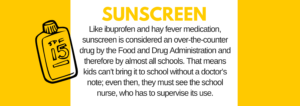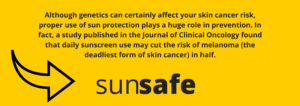Melanoma by the State: Utah


Utah has the unfortunate distinction of having the highest rate of melanoma in the nation—a rate more than double the national average. Despite increased public awareness, the most recent data shows that Utah’s melanoma rate has continued to rise steadily every year, more than doubling in the past 17 years, from 20 to 42 cases for every 100,000 people, according to the Utah Department of Health.
One area—the Summit County area, where Park City is located—has a startling rate of over 70 cases for every 100,000 people.
Why is the Melanoma Rate So High in Utah?
Besides being a state with a majority of white residents whose fair skin is a risk for melanoma, health officials think the high melanoma rate could be related to Uthans outdoor lifestyles. Why? It’s related to the rays.
There are two types of ultraviolet rays that penetrate Earth’s atmosphere and reach your skin: ultraviolet A (UVA) and ultraviolet B (UVB).
UVB rays are the main cause of sunburn. The intensity varies by time, season, and location, but the most significant amount of UVB hits the U.S. between 10 a.m. and 4 p.m. from April to October.
However, UVB rays can burn and damage your skin year-round, especially at high altitudes and on reflective surfaces such as snow or ice, which bounce back up to 80 percent of the rays, so that they hit the skin twice.
UVA rayspenetrate deeper into your skin and are responsible for skin aging and increase your risk of melanoma. UVA rays are present with relatively equal intensity year-round during daylight hours. Unlike UVB rays, they can penetrate clouds and fog.
Overall, the sun’s UV rays are more intense at higher elevations. At 10,000 feet, you’re 70 % more exposed to UV rays than at sea level.
What is Utah Doing About its Melanoma Rate?
One thing Utah is doing is protecting children. In 2017, Utah became one of a handful of states to understand the importance of sun safety for children at school when they passed H.B. 288.
The World Health Organization (“WHO”) reports that “Children spend much time in school, and UV radiation exposure during the school years contributes significantly to total lifetime sun exposure.” Children typically spend six to nine hours a day, five days a week at school. They are often outside for recess, P.E. classes, and other school or after-school activities when the sun’s rays are most intense, between 10 a.m. and 4 p.m. However, many schools throughout the country prohibit students from bringing sunscreen to school, let alone putting it on, without a doctor’s note because the U.S. Food and Drug Administration (the “FDA”) classifies sunscreen as an over-the-counter medication.

Representative Craig Hall and Senator Jacob Anderegg recognized this problem, and the two legislators, in 2017, sponsored H.B. 288. It was passed by the Utah Legislature and signed by the Governor, and it permits a student to carry and use sunscreen, that is regulated by the FDA, at a public school without a parent or physician’s authorization.
But there is still work to do. Many states still prohibit school-aged children from bringing, carrying, and using sunscreen at school without a physician’s authorization. Interested in helping this effort? Contact Samantha at sguild@AIMatMelanoma.org and learn how you can protect the youth in your state from the sun’s radiation. Join AIM at Melanoma in the fight!
Reminders to Reduce Melanoma Risk,
for Utahns and ALL of Us!
Establish an easy, daily sun protection regimen you can follow all year long.
Apply sunscreen each morning and reapply every two hours. In addition to daily sunscreen use, you should cover up with clothing, broad-brimmed hats, and UV-blocking sunglasses. Seek the shade, especially between 10 a.m. and 4 p.m., when the sun’s rays are strongest.
Continue using sunscreen during the winter and on cloudy days.
Both UVA and UVB rays play a role in the development of melanoma—and the rays can be just as powerful in winter or through clouds as they are on a sunny summer day. Make sun protection a daily habit, no matter the season and weather.

Do not let your skin burn.
On average, a person’s risk for melanoma doubles if he or she has had more than five sunburns. It’s important to take the time and effort to prevent sunburns in the first place. Protect your skin.
Check your skin.
It is recommended that adults over the age of 18 see a dermatologist once a year for a full skin exam. Adults should also perform monthly self-exams, looking for new or changing moles or lesions that should be examined by a healthcare provider.
Recent Posts

Behavioral Addiction Responsible for Excessive Indoor Tanning

Announcing AIM at Melanoma’s Official Sunscreen Partner, WearSPF

Red Hair Genetics: 5 Things You May Not Know

Surviving & Thriving: From Melanoma Survivor to Sun Safety Advocate


